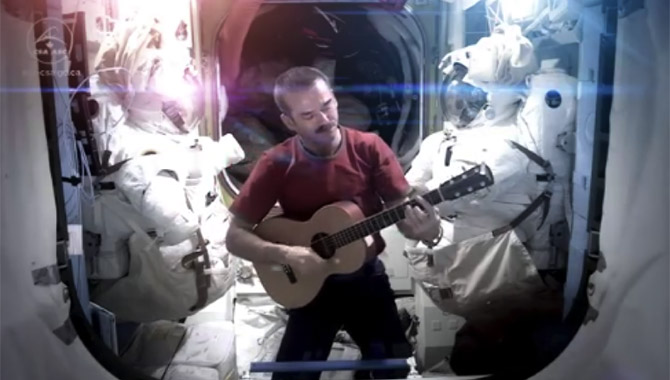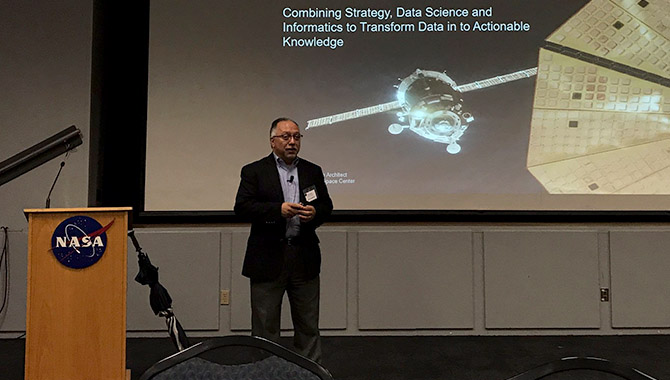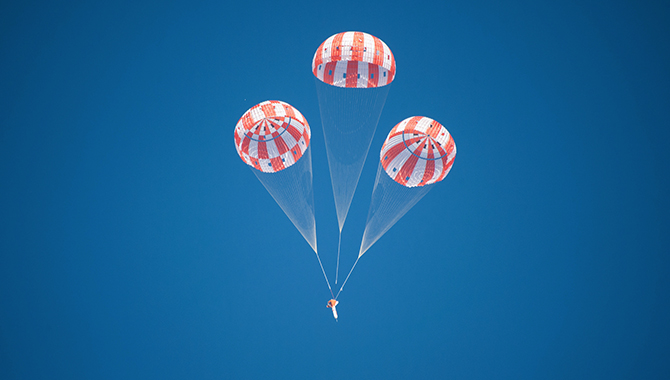
Vol. 6, Issue 3
How should we describe the different kinds of knowledge activities taking place across NASA?
Where knowledge is concerned, there is an abundance at NASA. As I mentioned in a previous column, the most striking thing about the convening of the agency’s knowledge community in February 2012 was the sheer depth and breadth of activity already underway at the centers and mission directorates. Over the course of a year, we compiled an initial inventory of all those activities and expanded this survey to include several cross-functional organizations, such as the Office of Procurement and the Office of Human Capital Management.
NASA’s Fermi Gamma-ray Space Telescope orbits our planet every 95 minutes, building up increasingly deeper views of the universe with every circuit. This image compresses eight individual frames, from a movie showing 51 months of position and exposure data by Fermi’s Large Area Telescope (LAT), into a single snapshot. The pattern reflects numerous motions of the spacecraft, including its orbit around Earth, the precession of its orbital plane, the manner in which the LAT nods north and south on alternate orbits, and more.Image Credit: NASA/DOE/Fermi LAT Collaboration (Click image for full size.)
After collecting all this data, the knowledge community faced a quandary: how should we slice and dice it? How should we group like activities together, and what terms should we use to describe them?
For starters, we recognized that knowledge takes many different forms. Some knowledge can be found through self-service, such as typing a query in a search box and getting an answer that points you in the right direction. That only involves one person at a time, and it only works with explicit knowledge that does not require a lot of context or personal judgment. If you want to learn the fundamentals of earned value management (EVM), for instance, the content can be codified and broken down into a series of concepts that you can learn without needing to consult a world-class expert in EVM.
At the other extreme, how do you learn to make go or no-go launch decisions when faced with data that raises uncertainties? In short, you cannot figure that out on your own. That kind of tacit knowledge is very dependent on context and personal judgment, and it requires social interaction between people. You can’t find get the full story from a Google search, and you’ll never grasp the context as fully from a video as from a face-to-face conversation, though technology can be helpful for extending the reach of personal story.
So given the range of possible knowledge activities from self-directed queries to social interactions like sharing stories with each other, we created a set of categories that addressed most of the activities taking place across NASA so that we could group them together for the knowledge map.
- Online Tools. Include but are not limited to: portals, document repositories, collaboration and sharing sites, and video libraries.
- Search/Tag/Taxonomy Tools. Dedicated search engine for knowledge (e.g., Google Search Appliance) and any initiatives related to meta-tagging or taxonomy.
- Case Studies/Publications. Original documents or multimedia case studies that capture project stories and associated lessons learned or best practices.
- Lessons Learned/Knowledge Processes. Any defined process that an organization uses to identify or capture knowledge, lessons learned, or best practices, including: Lessons Learned Information System vetting process, organization-specific lessons learned processes, benchmarking, use cases, knowledge sharing recognition programs, knowledge product validation processes, and communications about expectations related to knowledge sharing.
- Knowledge Networks. Any defined knowledge network, such as a community of practice, expert locator, mass collaboration activity, or workspace specifically designed to enable exchanges and collaboration.
- Social Exchanges. Any activities that bring people together in person to share knowledge (e.g., forums, workshops, Lunch and Learn/Pause and Learn, etc.). The reach of these activities can be multiplied through online tools such as videos and virtual dialogues.
These are by no means the only categories that could have been created, and they are not a perfect fit for every knowledge activity taking place at NASA. With an awareness that the perfect is the enemy of the good, the knowledge community decided to adopt these categories at our January 2013 meeting, understanding that this terminology could be improved in the future. For now, it is a start.
The names we give things do matter. When it comes to knowledge, what matters most is building a shared vocabulary across NASA so we understand each other. The activities we engage in may vary widely according to local customs and needs, but a common language helps build a more robust agency-wide knowledge capability and provides a basis for discussion within the agency as well as with our stakeholders.









